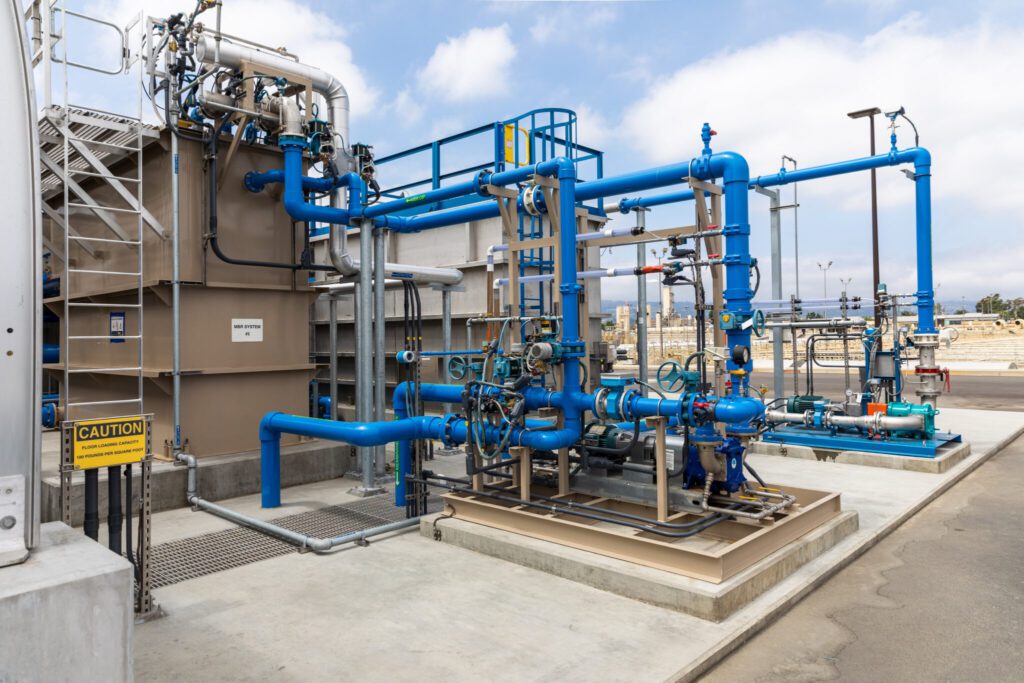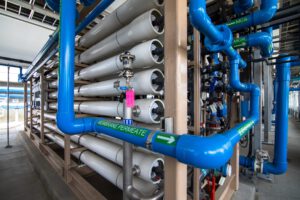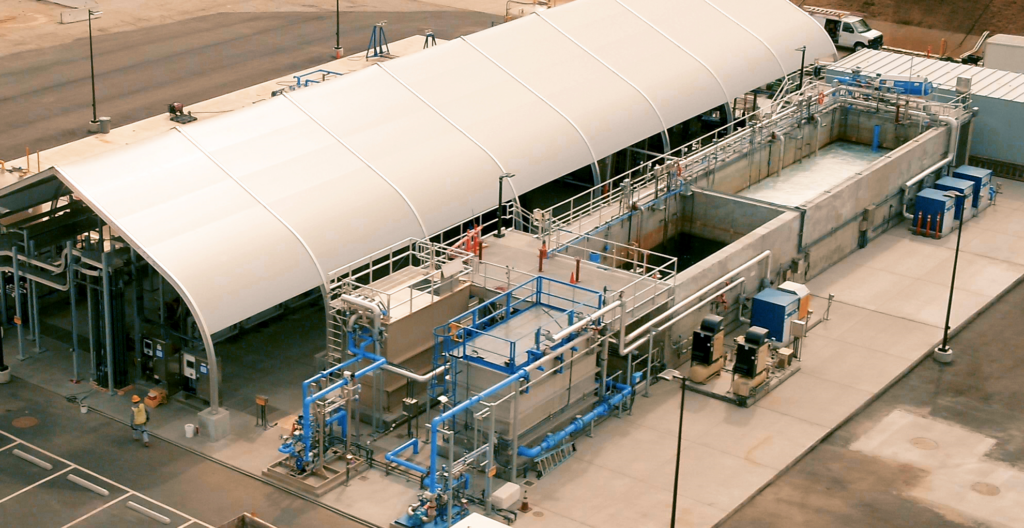The Metropolitan Water District of Southern California is a major water wholesaler that serves 26 member agencies across 6 heavily populated counties. Most of its water is imported from the Colorado River and Northern California, but increasing drought and demand have highlighted the limitations of these sources. For decades, Metropolitan has encouraged and incentivized its member agencies to develop local water supplies. Now, it is following suit, embarking on the development of a major recycled water project for the region, a drought-proof supply that could ultimately produce 150 million gallons a day (MGD) of recycled wastewater for groundwater augmentation, industrial uses and, eventually, direct potable reuse through raw water augmentation. The current step in this plan is the opening of a demonstration plant that will test the water reclamation procedures that the district would implement on a larger scale with a full-scale facility if the project is approved by Metropolitan’s board of directors.
In this interview, Deven Upadhyay, Metropolitan’s chief operating officer and assistant general manager, speaks with Municipal Water Leader Managing Editor Joshua Dill about the district’s demonstration plant and its plans for the future.
Joshua Dill: Please tell us about your background and how you came to be in your current position.
Deven Upadhyay: My background is actually in economics. I started in the water industry in 1995, working in Metropolitan’s planning group, which was focused on looking far into the future and projecting what demand might look like and what new supply programs would be needed. I worked in this group on long-term planning, facilities planning, and resource planning for about 10 years. At that point, I left Metropolitan to work for the Municipal Water District of Orange County (MWDOC) on water policy issues. MWDOC is one of Metropolitan’s larger customer agencies. It serves much of Orange County as a water wholesaler. At the time, one of MWDOC’s directors, Wes Bannister, had just been elected as Metropolitan’s chair of the board. I had the opportunity to work with him. It was a cool time to be working on water policy. A few years later, the position of manager of budget rates and financial planning opened up at Metropolitan. I ended up moving back to Metropolitan to take that position, and a few years later, I became the manager of water resources. About a year and a half ago, I became the chief operating officer and assistant general manager.
Joshua Dill: Would you give us an overview of Metropolitan and its services?

Deven Upadhyay: We are a large water wholesaler providing services to 26 member agencies. Metropolitan was formed and operates as a voluntary cooperative of its member agencies. In an average year, we provide about half the water that is used in urban Southern California. Our service area spans from Ventura County in the north to the Mexican border in the south, covering parts of Ventura, Los Angeles, Orange, Riverside, San Bernardino, and San Diego counties. In that service area, there are roughly 19 million people. We import water supplies through a system that we built and own and operate that brings water from the Colorado River. We also are the largest participant in the State Water Project, which the State of California built in the 1960s. We deliver that imported water to our member agencies, which include 13 cities, a number of water districts, and one county water authority. They and their own member agencies deliver that water, sometimes combined with local supplies, to residents and businesses throughout Southern California. We’ve got five drinking water treatment plants, the largest of which is the second-largest treatment plant in the United States. To give you a sense of our infrastructure’s scale, the replacement costs for that infrastructure would be about $22 billion. Our normal annual budget is about $1.7 billion. We have about 1,800 employees.
Joshua Dill: Would you tell us about the motivation behind developing your new recycled water demonstration plant?
Deven Upadhyay: Originally, Metropolitan was focused on developing and managing imported supplies. However, over time, our board shifted Metropolitan’s focus to becoming a leader in regional planning for water in Southern California. In this role, Metropolitan has adopted demand-management policies focusing on developing new local supplies and reducing consumption. In combination with imported supplies, these policies help ensure the region has a reliable water supply. In fact, the state legislature directed Metropolitan to increase conservation and local resource projects with SB60, which was signed into law in 1999.
Over the decades, we started finding ways to encourage Southern California to reduce per-capita water use through conservation programs. We offered rebates to incentivize consumers throughout the region to get new, more efficient toilets and low-flow showerheads or to replace their grass with drought-tolerant landscaping. We built a conservation outreach platform at bewaterwise.com. We did something similar to promote local supply development in the 1980s with our Local Resources Program. We established financial incentives and struck agreements with our customer agencies to encourage the development of recycled water plants and groundwater treatment plants to treat contaminated groundwater. These facilities typically cost more than our imported water, so we help make them more financially feasible with incentives.
Now we’re looking to take another major step toward developing recycled water for this region, in partnership with the Los Angeles County Sanitation Districts (LACSD). The full-scale plant that we’re talking about as part of this partnership would produce 150 MGD of reuse water and would be the largest facility of its kind in the United States. Because of that size and scale, we’re considering a different approach for this program: actually building, owning, and operating that facility ourselves as opposed to incentivizing another agency to do it. The project’s footprint extends far beyond the boundaries of any one of our member agencies, or even two together, and the project will improve reliability for all member agencies throughout the region, so it makes sense for a regional agency like Metropolitan to take it on. Another reason this approach makes sense is that we’re considering taking this water into our existing delivery systems through a process known as raw water augmentation. A portion of the purified recycled water would be put upstream of one, and potentially two, of our drinking water treatment facilities, treated again through traditional treatment methods, and then distributed via our treated water distribution system. The system would also deliver treated water to groundwater basins in Southern California for groundwater augmentation, as well as to some industrial users.

Our full-scale infrastructure will involve two major components: an advanced water treatment facility and a distribution system. It will involve about 60 miles of conveyance and distribution pipelines. If our board decides to move forward with the full-scale project, we anticipate that it will take 11 years from the authorization of the environmental work to the completion of the full-scale facilities. There are opportunities to accelerate the development of a portion of the project that could allow water to be produced and used by industrial users or groundwater basins in as few as 7 years.
Our demonstration facility is one of the early steps in this program. We entered into a formal partnership in 2015 with LACSD to develop an advanced water treatment demonstration facility, and we recently completed its construction. We are beginning the operations and testing phase in early September 2019 under a testing plan that has been approved by the State Water Resources Control Board. The facility will produce about 500,000 gallons a day and gives us the ability to test the use of an innovative treatment sequence that begins with membrane bioreactors, followed by reverse osmosis, UV treatment, and advanced oxidation. This process is a unique adaptation of existing technology in that it is testing the use of membrane bioreactors as a pretreatment for reverse osmosis. That process could significantly improve efficiencies in water recycling. We are testing its ability to meet groundwater augmentation regulations as well as industrial water requirements.
In a second phase of this project, we’ll be exploring the potential for raw water augmentation. There will likely be additional treatment processes and controls required, but we don’t yet know what those additional requirements will be. The state has initiated development of raw water augmentation regulations and is required to develop these regulations by the end of 2023. Future testing at Metropolitan’s demonstration facility may provide an opportunity to support the state in its regulatory development.
Joshua Dill: When you do raw water augmentation, are you required to put the reuse water in an environmental buffer like a reservoir?
Deven Upadhyay: That will depend on the feedback we get as regulations develop over the next 3½ years. In general, raw water augmentation would remove the environmental buffer that is required in the different forms of indirect potable reuse, such as groundwater augmentation and reservoir augmentation. There is potential for some storage buffer to be part of a raw water augmentation process, such as a small reservoir. We also anticipate additional treatment and enhanced monitoring to be required. When you look at the design for this program, most of the core treatment will happen at a site that is jointly located with the LACSD, the Joint Water Pollution Control Facility in the city of Carson, California, where the wastewater is treated before it is delivered. That’s where the demonstration plant is now and that’s where the full-scale facility will be. The purified water will then move into a backbone distribution system that would deliver water for industrial demands, groundwater augmentation needs, and potential raw water augmentation. The raw water augmentation piece will happen at the end of the system after these other deliveries are made. We need to define the additional treatment that is needed before raw water augmentation water goes into our conventional treatment facilities. We also need to identify whether that additional treatment should be done at the full-scale facility in Carson or at a satellite facility closer to our treatment plants. The advantage of a satellite treatment plant located next to a conventional treatment facility is that you are probably treating a lower flow volume, which means that the size of the additional treatment processes for raw water augmentation might be smaller and, therefore, cheaper.
The City of Los Angeles is also considering a large-scale recycling plant at its own Hyperion wastewater facility. We’ve signed a letter of intent with the city to develop a plan to coordinate the potential interconnection of the city’s project with the backbone system of Metropolitan’s project, so that some of the city’s purified wastewater could be moved through it up to the raw water augmentation scheme we are designing for our own treatment plants.
Joshua Dill: What would constitute success for the demonstration facility?
Deven Upadhyay: The State Board has approved a 15-month testing plan for a tertiary membrane bioreactor (MBR) process. That means we are taking effluent from the wastewater facility that has been treated to a secondary level and bringing it into our demonstration plant to continue the treatment process with the steps I mentioned above, starting with MBR. We are seeking recognition from the State Board that our treatment process is able to purify the water and meet all applicable regulations.
If that is successful, we will move on to a second testing plan to test the viability of a secondary MBR process. That involves taking effluent from the wastewater facility that has been treated to a primary level and moving it into the demonstration plant. There may be some cost efficiencies that can be realized through this treatment approach.

Success, for us, would be moving through that first testing plan and starting a second testing plan. We don’t intend to stop there. We eventually want to use this demonstration facility to develop a testing plan for raw water augmentation. We think we’re going to be getting value out of this demonstration facility for quite some time leading up to decisions on the full-scale facility, and we think we can do that in parallel with environmental work on the full-scale facility. While all of this is happening, we will be conducting tours at our demonstration facility to inform and educate a variety of stakeholders on the purification process employed and the overall program.
Joshua Dill: Would you talk about the broader landscape of water reuse in Southern California and how your projected full-scale facility fits into it?
Deven Upadhyay: We’ve learned a lot from the people who have done a ton of work on similar projects before us. The Water Replenishment District of Southern California, the West Basin Municipal Water District, and the Orange County Water District have paved the way using recycled water for seawater barriers and groundwater replenishment. That is informing the approach that we’re using with this facility. We’ve also had a lot of discussion and information sharing with the folks down at the City of San Diego, which is pursuing a reservoir augmentation project through their Pure Water project. And, as I mentioned, we’ve signed a letter of intent with the City of Los Angeles, allowing for coordination between our two large-scale recycling projects.
Looking at water reuse and recycling in Southern California, what we’re seeing is a continued evolution from recycled water efforts focused on external irrigation and industrial use to indirect potable reuse through seawater barriers, groundwater augmentation, and reservoir augmentation. Our vision is to move further in that direction by investigating raw water augmentation. We see this as a natural progression.
I think this is a turning point within the state. Water agencies are seizing opportunities to purify wastewater to develop drought-proof supplies. There’s also a fair amount of public support for this. Recycled water is an integral part of a portfolio, together with stormwater capture, imported supplies, local water supply development, and conservation efforts. All these resources put together can provide a robust and reliable portfolio for Southern California.
Deven Upadhyay is chief operating officer and assistant general manager of the Metropolitan Water District of Southern California. He can be contacted at dupadhyay@mwdh2o.com.
